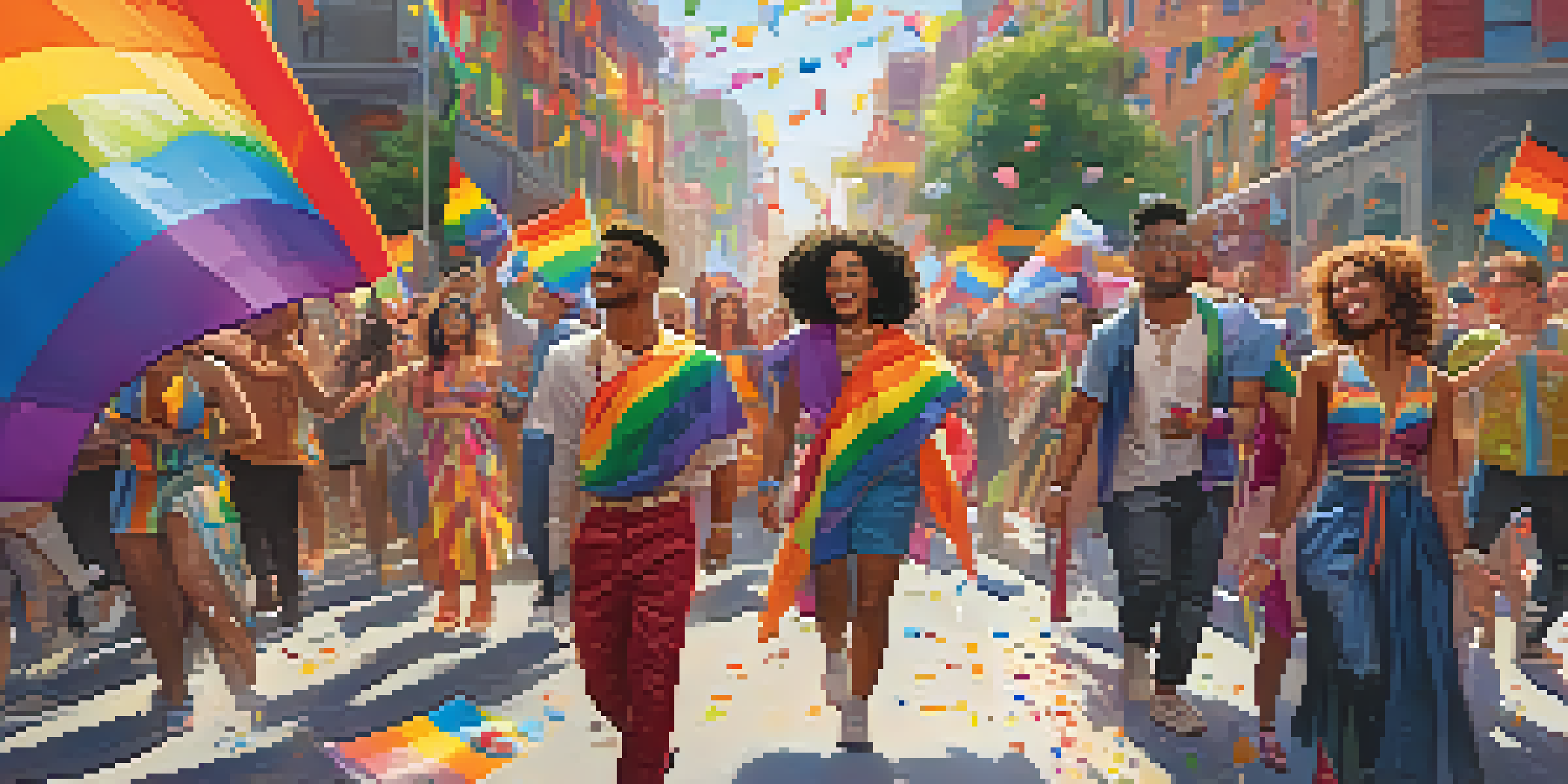Analyzing LGBTQ+ Characters in Major Hollywood Blockbusters

The Evolution of LGBTQ+ Characters in Film
Over the decades, LGBTQ+ representation in Hollywood has undergone significant transformation. In the early days, characters were often portrayed as stereotypes, lacking depth and humanity. However, as societal attitudes have evolved, so too have the stories told on screen, leading to more nuanced and authentic portrayals.
Representation matters. It’s about making sure that everyone can see themselves in the stories that are being told.
This shift began gaining momentum in the late 20th century, with films like 'Philadelphia' and 'Brokeback Mountain' challenging the status quo. These films not only featured LGBTQ+ characters but also tackled complex themes surrounding love, loss, and identity. This change paved the way for future filmmakers to explore diverse narratives without fear of backlash.
Today, major blockbusters are increasingly inclusive, showcasing LGBTQ+ characters as multifaceted individuals. This evolution reflects a broader cultural acceptance and highlights the importance of representation in shaping public perception and understanding of the LGBTQ+ community.
Key Themes in LGBTQ+ Storylines
LGBTQ+ characters often face unique challenges that can serve as focal points in their narratives. Themes such as identity, acceptance, and love are common, allowing audiences to connect with the characters on a personal level. For example, films like 'Moonlight' beautifully explore the intersection of race, sexuality, and personal growth, providing a rich tapestry of experiences.

Moreover, these storylines frequently highlight the struggle for acceptance, both from society and within one's own family. This theme resonates with many viewers who have experienced similar challenges, fostering empathy and understanding. The emotional depth of these characters often leads to more impactful storytelling.
Evolution of LGBTQ+ in Film
LGBTQ+ representation in Hollywood has transformed from stereotypes to nuanced portrayals, reflecting changing societal attitudes.
Another prevalent theme is resilience. Many LGBTQ+ characters demonstrate remarkable strength in overcoming adversity, showcasing their determination to live authentically. This narrative not only inspires those within the community but also educates those outside it about the realities many face.
The Impact of Representation on Audiences
The representation of LGBTQ+ characters in film can have a profound impact on audience perceptions and attitudes. When viewers see authentic portrayals of LGBTQ+ individuals, it can challenge stereotypes and foster acceptance. This is particularly important for younger audiences who are still forming their understanding of gender and sexuality.
The more we see LGBTQ+ characters in our media, the more we can understand their lives and the struggles they face.
Research has shown that diverse representation in media can lead to greater acceptance of marginalized communities. By seeing characters who reflect their own experiences, LGBTQ+ individuals may feel validated and empowered. For allies, these films can serve as a window into the complexities of LGBTQ+ lives, promoting empathy and understanding.
As Hollywood continues to embrace LGBTQ+ narratives, the potential for positive societal change grows. Films that portray LGBTQ+ characters with authenticity not only enrich the cinematic landscape but also play a crucial role in shaping cultural attitudes towards diversity.
Challenges in Authentic Representation
Despite the progress made, challenges still exist in achieving authentic representation of LGBTQ+ characters. One significant issue is the tendency for straight actors to be cast in LGBTQ+ roles, which can perpetuate the notion that these characters are not fully understood by those outside the community. This practice not only limits opportunities for LGBTQ+ actors but also raises questions about authenticity in storytelling.
Moreover, there is often pressure for LGBTQ+ characters to fit into specific narratives that align with mainstream expectations. This can lead to one-dimensional portrayals that do not accurately reflect the diverse experiences within the community. Filmmakers must strive to create complex characters that resonate with real-life experiences.
Authenticity Matters in Storytelling
Authentic representation of LGBTQ+ characters is crucial, as it enriches narratives and fosters empathy among audiences.
While progress is being made, it's crucial for audiences to advocate for better representation. Supporting films that prioritize authentic storytelling and diverse casting can help shift industry standards, encouraging Hollywood to take more risks with LGBTQ+ narratives.
Notable LGBTQ+ Characters in Recent Blockbusters
Recent Hollywood blockbusters have introduced a range of memorable LGBTQ+ characters that resonate with audiences. For instance, characters like 'Elio' in 'Call Me by Your Name' and 'Billy' in 'Rocketman' showcase the complexities of love and self-discovery. Their stories go beyond mere representation, delving into the emotional intricacies of their experiences.
Additionally, animated films have also contributed to this movement, with characters like 'Luca' from Disney-Pixar's 'Luca' hinting at LGBTQ+ themes through the lens of friendship and acceptance. These portrayals help to normalize LGBTQ+ identities in spaces that are often considered family-friendly, opening the door for younger audiences to engage with these narratives.
These notable characters not only entertain but also serve as catalysts for conversation and understanding. Their impact transcends the screen, encouraging discussions about love, acceptance, and the importance of being true to oneself.
The Role of Filmmakers and Storytellers
Filmmakers and storytellers play a vital role in shaping how LGBTQ+ characters are portrayed on screen. Their perspectives can bring authenticity and depth to narratives that might otherwise fall flat. By prioritizing diverse voices in the writing and directing processes, filmmakers can create stories that reflect the richness of LGBTQ+ experiences.
Moreover, collaboration with LGBTQ+ consultants and actors can enhance authenticity, ensuring that characters are portrayed with respect and nuance. This practice not only enriches the storytelling but also fosters a sense of ownership among the community, making the narratives feel more genuine.
Future Looks Bright for Representation
The rise of streaming platforms and audience demand for diverse stories signal a promising future for LGBTQ+ representation in film.
As the industry evolves, it's essential for creators to remain committed to inclusivity. By embracing diverse perspectives and experiences, filmmakers can contribute to a more representative cinematic landscape that resonates with a wider audience.
Looking Ahead: Future of LGBTQ+ Representation
The future of LGBTQ+ representation in Hollywood looks promising, with an increasing number of films and series dedicated to telling diverse stories. As audiences demand more authentic portrayals, the industry is beginning to respond by creating content that reflects the varied experiences within the community. This shift is not only beneficial for LGBTQ+ viewers but also for society as a whole.
Moreover, streaming platforms have opened up new avenues for storytelling, allowing for a broader range of voices to be heard. This democratization of content creation means that lesser-known stories and characters can find their way to audiences, enriching the overall narrative landscape. As a result, we can expect to see even more groundbreaking LGBTQ+ films in the coming years.

Ultimately, the journey towards authentic representation is ongoing. While strides have been made, it's crucial for both creators and audiences to continue advocating for diversity and inclusion in storytelling. By doing so, we can help ensure that LGBTQ+ characters are portrayed in ways that resonate with authenticity and depth.